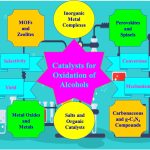Researchers at Amirkabir University of Technology have conducted a comprehensive review of recent innovations in alcohol oxidation and the role of various catalysts in this fundamental chemical process.
According to the Report, alcohols are among the basic feedstocks of the chemical industry. Their conversion into ketones, aldehydes, and acids paves the way for producing a wide range of essential products, from pharmaceuticals and cosmetics to plastics and food additives. What distinguishes this study is its broad examination of catalysts, including inorganic metal complexes, metal–organic frameworks (MOFs), carbon nanomaterials, and organic catalysts, that can reduce costs, enhance efficiency, and, importantly, eliminate toxic oxidants, thereby promoting a more sustainable chemical industry. The researchers not only analyzed the activity and stability of these catalysts but also elucidated key reaction mechanisms, providing a foundation for developing greener and more economical processes.
Alcohol oxidation, one of the most fundamental reactions in chemical industries, plays a vital role in producing intermediates and high-value compounds. Products such as plastics, detergents, dyes, pharmaceuticals, and food additives all rely on these key transformations. For instance, the oxidation of benzyl alcohol to benzaldehyde is a strategic reaction, as benzaldehyde is widely used in the textile, agricultural, pharmaceutical, and cosmetic industries.
Despite its industrial significance, traditional oxidation methods face numerous challenges. The use of costly and toxic oxidants such as bromine, chromium, and permanganate not only causes environmental pollution but also requires harsh laboratory conditions, including high temperature, high pressure, and long reaction times. These limitations underscore the urgent need for greener and more efficient alternatives.
In response, researchers at Amirkabir University of Technology have conducted a comprehensive review of recent progress in the use of novel catalysts for alcohol oxidation. The study covers a wide spectrum of catalytic materials, each offering distinct structural and chemical features that can improve reaction yield, selectivity, and stability.
One major focus is on inorganic metal complexes, known for their tunable electronic and spatial structures, which make them versatile catalysts in numerous chemical reactions. Particularly, manganese complexes, which mimic the behavior of natural enzymes, have shown remarkable efficiency in alcohol oxidation.
Another class of materials drawing significant attention is metal–organic frameworks (MOFs). These porous structures, with large surface areas and tunable coordination sites, enable precise control over selective reactions. Combining MOFs with semiconductors or metals can lead to heterostructures that enhance charge separation and photoactivity, boosting catalytic performance.
Zeolites, with their crystalline framework and uniform micropores, also exhibit high catalytic selectivity. Incorporating transition metals such as silver, copper, or titanium into zeolite frameworks significantly improves their efficiency in alcohol oxidation.
Among metal oxides, compounds like TiO₂ and Nb₂O₅, as well as perovskite and spinel structures, have attracted much interest. Perovskites, due to their thermal stability and compositional flexibility, demonstrate outstanding performance in oxidation reactions. Spinels, on the other hand, are chemically stable and can substitute costly precious metals with more eco-friendly and low-cost alternatives.
In recent years, carbon-based materials such as graphene, carbon nanotubes, and graphitic carbon nitride (g-C₃N₄) have emerged as promising catalysts. Through heteroatom doping (e.g., nitrogen, phosphorus, or sulfur), their catalytic activity can be significantly enhanced. For example, nitrogen-doped graphene has shown higher efficiency in the oxidation of benzyl alcohol compared with its undoped counterparts.
Furthermore, oxoammonium salts and organic catalysts have been introduced as metal-free alternatives that offer high stability and recyclability, aligning with the principles of green chemistry. Notably, compounds such as TEMPO, when combined with copper salts, can drive oxidation reactions under mild conditions without producing toxic by-products.
Beyond cataloging these catalyst families, the Amirkabir research team also emphasized the mechanistic understanding of the oxidation process. Identifying active oxidizing species and surface processes is seen as crucial for optimizing catalytic performance. The study also investigates how variables such as temperature, solvent, catalyst dosage, and oxidant type influence overall efficiency.
The significance of this research lies in demonstrating that novel catalysts can make essential chemical reactions more cost-effective, efficient, and environmentally benign. This approach not only promotes sustainable chemical production but also reduces dependence on hazardous and polluting materials.
In conclusion, the review highlights that the future of the chemical industry depends on the advancement of green, durable, and recyclable catalysts, which can transform the way vital industrial reactions are carried out.



